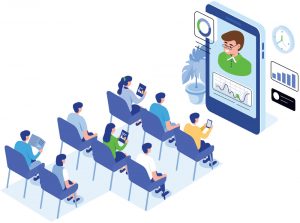
Field Training From the ‘Home Office’
Why are we so exhausted by virtual training?
Feature Story – By Amy Glass
 As an extrovert — someone who has built a career helping individuals, leaders and teams thrive — I miss connecting with people in person. I miss the energy I get from teaching and coaching through face-to-face interactions. As field trainers, I think we all share a deep interest in how people learn and grow. We wonder, can we make an impact in this virtual environment the way we did with in-person learning?
As an extrovert — someone who has built a career helping individuals, leaders and teams thrive — I miss connecting with people in person. I miss the energy I get from teaching and coaching through face-to-face interactions. As field trainers, I think we all share a deep interest in how people learn and grow. We wonder, can we make an impact in this virtual environment the way we did with in-person learning?
The pandemic has been challenging in so many ways, with worries about health, finances, children’s schooling (often from home) and balancing it all with a full-time job. Still, we have adapted and have gotten increasingly comfortable on virtual platforms like Zoom, Teams and others.
The longer I have used these platforms, the more curious I have became as to why meeting virtually does not fully replicate the in-person experience. Instead of being energized by interacting with people, even extroverts feel tired. Instead of building relationships, meetings feel so much more transactional.
Why are we so exhausted by virtual training?
Humble Beginnings
I remember my first virtual training 10 years ago. It was for a global group at a pharmaceutical company where team members joined from Europe, China and South Korea. Due to the time zone differences, I needed to start at 4 a.m. Eastern Standard Time.
Although I used the strategies and techniques I had learned from a decade of facilitation experience, it was exhausting. My husband asked how it was, and I said, “I could have flown to Shanghai and delivered this training and been less exhausted.”
Why is that? Shouldn’t virtual training take less effort than face-to-face meetings? Not necessarily. Being on virtual video platforms demands more sustained focus.
Gianpiero Petriglieri, an associate professor at Insead who explores sustainable learning and development in the workplace, said, “Video chats mean we need to work harder to process nonverbal cues like facial expressions, the tone and pitch of the voice, and body language; paying more attention to these consumes a lot of energy. Our minds are together when our bodies feel we’re not. That dissonance, which causes people to have conflicting feelings, is exhausting. You cannot relax into the conversation naturally.”
In a face-to-face training, we read the room and adjust accordingly. Imagine our brains trying to read 20 or more “virtual rooms” at the same time, while keeping an eye on our own virtual presence and managing the platform tools. Information overload!
What Can You Do About It?
Here are a few tricks field trainers can try:
- Invest time in building relationships. Take time to ask learners how they are doing. Begin the training by connecting with people. If you were meeting in person, this would be the time when you made “small talk” with the people who started trickling into the classroom.
- Try using the OAR approach — Observe-Ask-Reveal. Observe their background, ask about the art, books and framed pictures you see, then reveal something about yourself. Empathy is an easy way to demonstrate that you care about them as people, not only as learners.
- Treat the camera as a person. Remember there are humans behind the camera — and use eye contact and facial expressions to foster a connection. One simple tip is to stick a post-it with a smiley face by the camera as a reminder. Treating your camera like a person also means you don’t need to stare at it the entire time you are training. Just as you wouldn’t stare at a person constantly, you can look down to write a note or take a sip of coffee.
- Frame yourself carefully. Proximity plays a big part in how learners perceive you. The farther away or more obscured you appear, the less engaging you will be. First, you want to be at eye level with your camera, as if you were talking to someone who was the same height as you. You may need to lower your chair or put some books under your laptop to raise it. Once you are eye level, you want to frame yourself in the camera view showing your head and shoulders. You should sit about one arm-length away from your computer. Try making a fist and putting it on top of your head. If you can see the entire fist in the frame and it is close to the very top of the frame, you have good headroom.
- Remove distractions. Distracting elements will pull attention away from you. Are there items in the room that would not be at an office (like your bed)? Also consider that political or religious items can be polarizing. Move them or keep them out of your camera view.
- Hide yourself. It can be hard to focus if you’re distracted by how you look. Consider setting up your videocam ahead of time and then hiding your self view. Eliminating this distraction can help you engage more fully in the conversation and training content.
- Have phone meetings. Yes, training programs should be on video-enabled platforms, but field trainers also have other meetings with teams and internal stakeholders. Research on how to avoid “Zoom fatigue” has made the point that not every meeting needs to be on video. Since being on video demands so much more sustained focus, it is a good idea — especially for one-on-one — to meet over the phone.
Virtual Training in the Long Term
The COVID-19 in the pandemic will not last forever. We all hope that we are at the beginning of the end of this pandemic. Personally, I can’t wait to train in-person again — and I won’t take it for granted!
Still, many training programs will continue to be virtual. Companies are starting to recognize some benefits of virtual training: travel costs and time saved, flexible scheduling with multiple touchpoints over time and technology-supported learning application.
So, there’s a clear need to continue finding ways to improve virtual training for the long term.
Amy Glass is owner & CEO of BRODY Professional Development. Email Amy at
aglass@brodypro.com.








